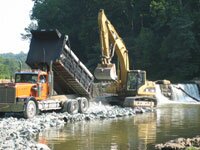NEWS- Going down: River runs through old dam

Woolen Mills dam goes down August 14, as a trackhoe attacks it from a recently constructed causeway.
PHOTO BY ERIN HEISTERMAN
For 137 years, the Woolen Mills dam has harnessed the flow of the Rivanna River– and impeded the reproductive efforts of the native shad that once spawned up and down the river. The beginning of the end of that era was August 14, when heavy machinery began moving the dam's giant blocks of granite.
"I am very sorry to see it go," says Presley Thach, whose family owns the dam and the actual Woolen Mills, which the dam once powered. While he okayed removal of most of the dam, the decision wasn't without mixed emotions, feelings he believes are shared by most of the residents of the neighborhood.
"People are sad to see it go, but most see the advantage to it going," Thach says.
"I think it's ridiculous," says dam supporter William Stevenson, "to give those fish another mile or two to swim before the big dam. By that reasoning, we should take the Rivanna reservoir down, too. [Woolen Mills] is 177 years old. You'd think it would have historic protection."
History and environment clashed over plans to breach the dam, which Rivanna Conservation Society member Jason Halbert has labored for six years to open up.
Now, within a week, two area dams will be history. Last week saw the removal of the Tye River dam in Nelson County.
The partial breach of the Woolen Mills dam is definitely the more controversial project. The plan calls for all but 75 feet of the 270-foot granite block structure to be demolished, the partial teardown a nod to 1830, when Rivanna River water helped the Charlottesville Woolen Mills to manufacture its woolens and, later, cloth for Confederate soldiers' uniforms. If the remaining dam is unstable, it will all come down.
Shelbeck Excavation of Fluvanna built a causeway out to the dam, and on Tuesday, a trackhoe rolled out and started "grabbing" it, says Halbert. The $250,000 demolition– funded by donations– will take about two weeks.
"The plan is to drop it slowly," Halbert says. "Who knows what we'll find? There could be surprises."
Over 500 trees and shrubs will be planted this fall and next spring, says Halbert, and a kiosk will be built on the east side of the river to serve as a historic marker for the site.
Down in Nelson, the Tye River dam is already down, and debris is being removed from the August 7 demolition. "It was much simpler," says Halbert, who coordinated both projects. "We had to deal with one family, and they were very cooperative."
That dam was inherited by Charlottesville resident Bess Quinn in the 1950s, and in a release her children, who own it today, say it was her wish that the 100-year-old structure near the Amherst border come down.
"It was the only dam on the Tye River," says Halbert, and now that river, popular with anglers, kayakers, and canoers, is unobstructed from the Blue Ridge Mountains to the James River.
Halbert is taking a break from dam breaching, focusing instead on his three-month-old son. "Maybe I'll float down the river with him," muses the new dad.
And maybe he'll be joined by some of the million or so shad fry he's released over the past couple of years, coming back to spawn in their native waters for the first time in centuries.
#